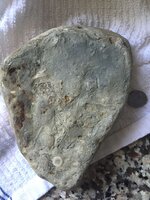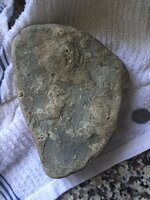Navigation
Install the app
How to install the app on iOS
Follow along with the video below to see how to install our site as a web app on your home screen.
Note: This feature may not be available in some browsers.
More options
You are using an out of date browser. It may not display this or other websites correctly.
You should upgrade or use an alternative browser.
You should upgrade or use an alternative browser.
Best way to clean.
- Thread starter PennyG
- Start date
DDancer
Bronze Member
- Mar 25, 2014
- 2,339
- 2,003
- Detector(s) used
- Current Equinox 600
Past Whites DFX Garret GTI 2500 and others
Prospecting Minelab GPZ 7000
Past SD 2100 GP 3000 (retired)
- Primary Interest:
- All Treasure Hunting
It appears you have a stone containing fossils. The grey stuff would be fossil remains~ cleaning beyond this point will harm the material. Picking at it with a sharp scribe can probably free up some material and expose other fossils under the layers.
Upvote
0
huntsman53
Gold Member
I wonder if the lightly acidic cleaning properties of Extra Virgin Olive Oil might loosen and help remove some of the heavier grey sediment??!! I have used it on Copper coins for many years to remove dirt, grime and encrustations and believe it would work on rocks as well. Even if it does not loosen and remove the sediment, it will probably stabilize the rock from decay and give it a nice appearance. If you decide to try Extra Virgin Olive Oil, afterward it's use, just rinse the rock with water then dry with a towel.
Frank
Frank
Upvote
0
huntsman53
Gold Member
I read where some use vinegar or lemon juice. Just not sure on that.
Both vinegar and lemon juice are used on coins depending what they need but I think that they could be harmful to certain types of rocks, especially vinegar. However, I am not totally sure but you could do a test on a very small section of rock where it would not be noticed or noticed as much in case it is harmful.
Frank
Upvote
0
EricTheCat
Sr. Member
I would echo huntsman53's concerns about vinegar, I personally would not use vinegar or anything that acidic on a fossil specimen like that. Vinegar is great for cleaning off sediment like that but the fossil details could be eaten away in the process. Keep the vinegar around for a quartz/agate (for example) specimen that has sediment on it though, I have had excellent luck giving agates/quartz a vinegar bath to eliminate severe sediment.
Upvote
0
Top Member Reactions
-
 3467
3467 -
 2067
2067 -
 1979
1979 -
 1156
1156 -
 1142
1142 -
 926
926 -
 833
833 -
 812
812 -
 807
807 -
 789
789 -
 747
747 -
 530
530 -
 481
481 -
 471
471 -
 445
445 -
 422
422 -
E
416
-
 416
416 -
 413
413 -
 397
397
Users who are viewing this thread
Total: 2 (members: 0, guests: 2)





